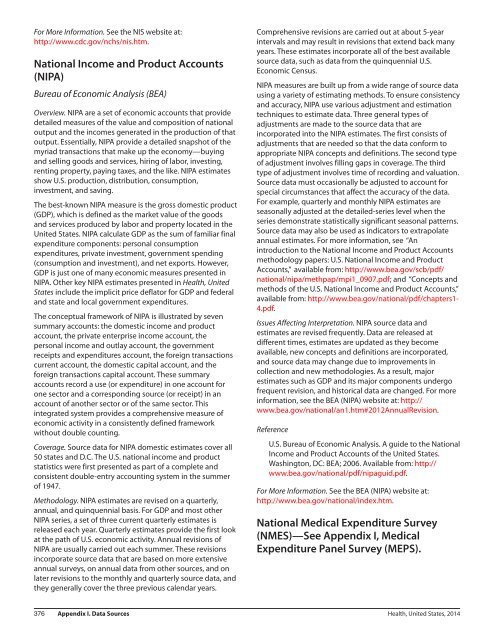hus14
hus14
hus14
You also want an ePaper? Increase the reach of your titles
YUMPU automatically turns print PDFs into web optimized ePapers that Google loves.
For More Information. See the NIS website at:<br />
http://www.cdc.gov/nchs/nis.htm.<br />
National Income and Product Accounts<br />
(NIPA)<br />
Bureau of Economic Analysis (BEA)<br />
Overview. NIPA are a set of economic accounts that provide<br />
detailed measures of the value and composition of national<br />
output and the incomes generated in the production of that<br />
output. Essentially, NIPA provide a detailed snapshot of the<br />
myriad transactions that make up the economy—buying<br />
and selling goods and services, hiring of labor, investing,<br />
renting property, paying taxes, and the like. NIPA estimates<br />
show U.S. production, distribution, consumption,<br />
investment, and saving.<br />
The best-known NIPA measure is the gross domestic product<br />
(GDP), which is defined as the market value of the goods<br />
and services produced by labor and property located in the<br />
United States. NIPA calculate GDP as the sum of familiar final<br />
expenditure components: personal consumption<br />
expenditures, private investment, government spending<br />
(consumption and investment), and net exports. However,<br />
GDP is just one of many economic measures presented in<br />
NIPA. Other key NIPA estimates presented in Health, United<br />
States include the implicit price deflator for GDP and federal<br />
and state and local government expenditures.<br />
The conceptual framework of NIPA is illustrated by seven<br />
summary accounts: the domestic income and product<br />
account, the private enterprise income account, the<br />
personal income and outlay account, the government<br />
receipts and expenditures account, the foreign transactions<br />
current account, the domestic capital account, and the<br />
foreign transactions capital account. These summary<br />
accounts record a use (or expenditure) in one account for<br />
one sector and a corresponding source (or receipt) in an<br />
account of another sector or of the same sector. This<br />
integrated system provides a comprehensive measure of<br />
economic activity in a consistently defined framework<br />
without double counting.<br />
Coverage. Source data for NIPA domestic estimates cover all<br />
50 states and D.C. The U.S. national income and product<br />
statistics were first presented as part of a complete and<br />
consistent double-entry accounting system in the summer<br />
of 1947.<br />
Methodology. NIPA estimates are revised on a quarterly,<br />
annual, and quinquennial basis. For GDP and most other<br />
NIPA series, a set of three current quarterly estimates is<br />
released each year. Quarterly estimates provide the first look<br />
at the path of U.S. economic activity. Annual revisions of<br />
NIPA are usually carried out each summer. These revisions<br />
incorporate source data that are based on more extensive<br />
annual surveys, on annual data from other sources, and on<br />
later revisions to the monthly and quarterly source data, and<br />
they generally cover the three previous calendar years.<br />
Comprehensive revisions are carried out at about 5-year<br />
intervals and may result in revisions that extend back many<br />
years. These estimates incorporate all of the best available<br />
source data, such as data from the quinquennial U.S.<br />
Economic Census.<br />
NIPA measures are built up from a wide range of source data<br />
using a variety of estimating methods. To ensure consistency<br />
and accuracy, NIPA use various adjustment and estimation<br />
techniques to estimate data. Three general types of<br />
adjustments are made to the source data that are<br />
incorporated into the NIPA estimates. The first consists of<br />
adjustments that are needed so that the data conform to<br />
appropriate NIPA concepts and definitions. The second type<br />
of adjustment involves filling gaps in coverage. The third<br />
type of adjustment involves time of recording and valuation.<br />
Source data must occasionally be adjusted to account for<br />
special circumstances that affect the accuracy of the data.<br />
For example, quarterly and monthly NIPA estimates are<br />
seasonally adjusted at the detailed-series level when the<br />
series demonstrate statistically significant seasonal patterns.<br />
Source data may also be used as indicators to extrapolate<br />
annual estimates. For more information, see ‘‘An<br />
introduction to the National Income and Product Accounts<br />
methodology papers: U.S. National Income and Product<br />
Accounts,’’ available from: http://www.bea.gov/scb/pdf/<br />
national/nipa/methpap/mpi1_0907.pdf; and ‘‘Concepts and<br />
methods of the U.S. National Income and Product Accounts,’’<br />
available from: http://www.bea.gov/national/pdf/chapters1<br />
4.pdf.<br />
Issues Affecting Interpretation. NIPA source data and<br />
estimates are revised frequently. Data are released at<br />
different times, estimates are updated as they become<br />
available, new concepts and definitions are incorporated,<br />
and source data may change due to improvements in<br />
collection and new methodologies. As a result, major<br />
estimates such as GDP and its major components undergo<br />
frequent revision, and historical data are changed. For more<br />
information, see the BEA (NIPA) website at: http://<br />
www.bea.gov/national/an1.htm#2012AnnualRevision.<br />
Reference<br />
U.S. Bureau of Economic Analysis. A guide to the National<br />
Income and Product Accounts of the United States.<br />
Washington, DC: BEA; 2006. Available from: http://<br />
www.bea.gov/national/pdf/nipaguid.pdf.<br />
For More Information. See the BEA (NIPA) website at:<br />
http://www.bea.gov/national/index.htm.<br />
National Medical Expenditure Survey<br />
(NMES)—See Appendix I, Medical<br />
Expenditure Panel Survey (MEPS).<br />
376 Appendix I. Data Sources Health, United States, 2014


